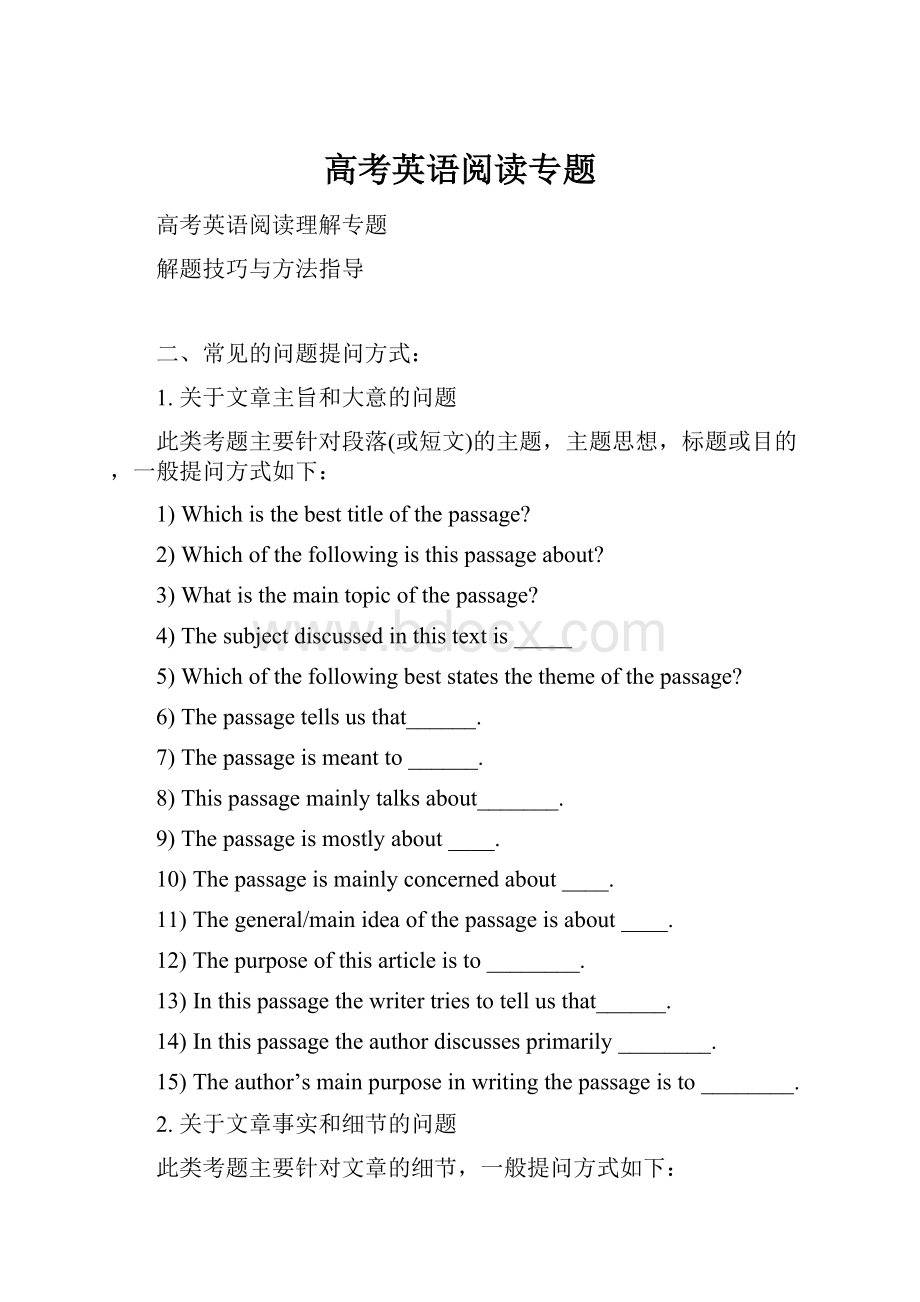高考英语阅读专题.docx
《高考英语阅读专题.docx》由会员分享,可在线阅读,更多相关《高考英语阅读专题.docx(34页珍藏版)》请在冰豆网上搜索。

高考英语阅读专题
高考英语阅读理解专题
解题技巧与方法指导
二、常见的问题提问方式:
1.关于文章主旨和大意的问题
此类考题主要针对段落(或短文)的主题,主题思想,标题或目的,一般提问方式如下:
1)Whichisthebesttitleofthepassage?
2)Whichofthefollowingisthispassageabout?
3)Whatisthemaintopicofthepassage?
4)Thesubjectdiscussedinthistextis_____
5)Whichofthefollowingbeststatesthethemeofthepassage?
6)Thepassagetellsusthat______.
7)Thepassageismeantto______.
8)Thispassagemainlytalksabout_______.
9)Thepassageismostlyabout____.
10)Thepassageismainlyconcernedabout____.
11)Thegeneral/mainideaofthepassageisabout____.
12)Thepurposeofthisarticleisto________.
13)Inthispassagethewritertriestotellusthat______.
14)Inthispassagetheauthordiscussesprimarily________.
15)Theauthor’smainpurposeinwritingthepassageisto________.
2.关于文章事实和细节的问题
此类考题主要针对文章的细节,一般提问方式如下:
1)Whichofthefollowingisright?
2)WhichofthefollowingisNOTtrueaccordingtotheinformationinthepassage?
3)Whichofthefollowingstatementsiscorrectaccordingtothepassage?
4)WhichofthefollowingisNotTrueinthepassage?
5)Whichofthefollowingisnotmentioned?
6)Whichofthefollowingismentionedinthepassage?
7)Theauthormentionsallofthefollowingexcept______.
8)Thewritermentionsalloftheitemslistedbelowexcept______.
9)Whatistheexampleof...asdescribedinthepassage?
10)Choosetherightorderofthispassage.
11)Accordingtothepassage,when(where,why,how,who,etc.)...
12)Thereasonfor...is________.
13)Fromthispassageweknowthat________.
14)Inthepassage,theauthorstatesthat______.
3.猜测词义的问题
此类考题目要求考生能根据上下文确定某一特定的词或短语的准确含义。
一般提问方式如下:
1)Theword“ABC”inthepassageprobablymeans________.
2)Theunderlinedword“ABC”inthepassagerefersto/means_______.
3)Whichofthefollowingisclosestinmeaningtotheunderlinedwordinthesecondparagraph?
4)Theunderlinedsentenceinthelastparagraphmeans______.
5)Theword"it(them)"inthefirstparagraphrefersto______.
4.关于对全篇逻辑关系的理解、对文章各段、各句间逻辑关系的理解的问题
此类考题主要考查句与句之间,短语与短语之间的逻辑关系,一般提问方式如下:
1)Manyvisitorscometothewriter’scityto________.
2)SomeshopscanbebuiltDongfengSquaresothattheymay_____.
3)Airpollutionisthemostseriouskindofpollutionbecause_____.
4)WhydidthewritergetoffthetraintwostopsbeforeViennastation?
5.关于推理和判断的问题
此类考题一般针对短文内容和考生应有的常识,文章中虽然没有明确的答案,但考生在理解全文的基础上可以进行推理和判断其答案。
一般提问方式如下:
1)Wecanguessthewriterofthelettermaybea______.
2)Wecaninferfromthetextthat_______.
3)Itcanbeinferredfromthetextthat______.
4)Fromtheletterswe’velearnedthatit’svery______toknowsomethingaboutAmericansocialcustoms.
5)Fromthestorywecanguess______.
6)Fromthetextweknowthat______.
7)Whatwouldbehappyif…?
8)Thestoryimpliesthat______.
9)Theparagraphfollowingthepassagewillmostprobablybe______.
10)Thewriter’sattitudetoward...is______.
11)Theauthorimplied(suggested)that_______.
12)Itmaybeconcludedfromthepassagethat_______.
13)Whichofthefollowingstatementsdoesthepassagesupport?
14)Withwhichofthefollowingdoestheauthoragree?
6.关于作者意图、观点或态度的问题
此类题目的主要提问方式是一般提问方式如下:
1)Howdidthewriterfeel…?
2)Theauthorseemstothinkthat______.
3)Thewriterwritesthistextto______.
4)Thewriterbelievesthat______.
5)Thewritersuggeststhat______.
6)Theauthorwantstoappealto_______.
7)Thewriteristryingtopresentapointofviewin______.
8)Theauthor’sstyleis______.
9)Theauthor’stonewouldbebestdescribedas_______.
10)Whatistheauthor’sopinionof______?
11)Whatistheauthor'smainpurposeinthepassage?
12)Intheauthor'sopinion_________?
三、题目类型
A类题:
可以直接从原文中找到答案的题目
A类题为拿分题
丢分原因:
1)凭印象做题,准确率低。
2)时间把握不好最容易出问题:
忘记内容的时候往往会回到文章中去找答案,一篇文章往往要读好几遍。
A类题解题技巧:
看清题目所问的内容之后,要在原文中划出原句,并标上题号。
这样做的目的:
1)做到万无一失,保证把该拿到的分数拿到手。
2)减少阅读文章的次数,争取宝贵的时间。
B类题:
不能够从原文中直接找到答案的题
此类题需要经过分析、判断、推理之后才能解答的题。
该类题是失分题,往往是出题人用来拉开学生梯度和层次的题。
B类题包括:
文章主题和中心大意等,一般都是主旨题。
B类题解题技巧:
1)以原文为依据,不参杂个人意见,要客观不要主观。
2)答案是比出来的。
答案不选对的,只选最好的。
因为,有时候四个答案都是对的。
所以,当看到第一答案是正确的时候,也要看后面的答案。
遇到这种情况,往往有学生钻牛角尖。
老师给学生解释的时候,也可以这样说:
你的答案没错,但是另一个答案更好,更全面。
答案不选对的,只选最好的。
3)注意绝对化的词。
如果答案选项中出现绝对化的词,比如:
all,always,never,nothing,every等等,除非文章当中使用了该类词汇,否则,一般都要排除。
比如,原文中出现了这样一个句子:
Almosteveryonelikesthemusic.答题时,出现了如下选项:
Everyonelikesthemusic.——该句子是错误的。
4)答案要避免以点带面,以偏概全。
尤其是多个选项都有道理,难以挑选正确答案的时候,要注意选择最符合题目要求的一个。
5)“傻瓜”原则。
文章中没有提到的就当不知道,不要枉自猜测,自作聪明。
一切以文章内容为准。
四、阅读理解解题步骤
第一步:
先读题
第二步:
读文章
第三步:
解题
实战阅读方法
一、巧用主题句并依据主题句确定短文的中心
最有效的办法是找出主题句。
一篇文章(或一段文章)通常都是围绕一个中心意思展开的。
而这个中心意思往往由一个句子来概括。
这个能概括文章或段落中心意思的句子叫做主题句。
因此,理解一个段落或一篇文章的中心意思首先要学会寻找主题句。
主题句一般具有三个特点:
(1)概括性强:
表述的意思比较概括。
(2)结构简单:
句子结构较简单,多数都不采用长、难句的形式。
(3)受它支撑:
段落中其他的句子是用来解释、支撑或发展该句所表述的主题思想。
在一篇短文或一个段落中,大部分主题句的位置情况有三种:
主题句在段首或篇首
主题句在段首或篇首的情况相当普遍,其后的句子则是论证性细节。
一般新闻报道、说明文、议论文、科技文献等大都采用这种格式,即先总述,后分述的叙事方法。
例文1:
Alllivingthingsontheearthneedotherlivingthingstolive.Nothinglivesalone.Mostanimalsmustliveinagroup,andevenaplantgrowsclosetogetherwithothersofthesamekind.Sometimesonelivingthingkillsanother,oneeatsandtheotheriseaten.Eachkindoflifeeatsanotherkindoflifeinordertolive,andtogethertheyformafoodchain(食物链).Somefoodchainsbecomebrokenupifoneofthelinksdisappears.
例文2:
Peoplehavedifferenttastesinfood.Somefeelthattheyhaven'teatenamealunlesstheyhavehadsteakorotherredmeat.Somepreferchickenorfishandeatoneortheotherateverymeal.Othersprefervegetablesandfruitsorgrainsandwouldenjoyamealofspaghetti,eggplant,andfreshfruit.Otherscouldliveonwhatwerecalledfast--foods:
ahamburgerorhotdog,Frenchfriesandasoftdrink.
主题句在段末或篇末
主题句也会出现在段尾,即作者先摆出事实依据,层层推理论证,最后自然得出结论--段落的主题。
这种位于段末或篇末的主题句往往是对前面细节的归纳总结或者所得出的结论。
因此,在阅读这种文章时,要注意表述细节的句子通常在前,概述性的句子在后,并以此结尾。
例文1:
Ifyoubuysomewell-madeclothes,youcansavemoneybecausetheycanlastlonger.Theylookgoodevenaftertheyhavebeenwashedmanytimes.Sometimessomeclothescostmoremoney,butitdoesnotmeanthattheyarealwaysbettermade,ortheyalwaysfitbetter.Inotherwords,somelessexpensiveclotheslookandfitbetterthanmoreexpensiveclothes.
例文2:
Somestudentspreferastrictteacherwhotellsthemexactlywhattodo.Othersprefertobelefttoworkontheirown.Stillotherslikeademocraticdiscussiontypeofclass.Nooneteachingmethodcanbedevisedtosatisfyallstudentsatthesametime.
主题句在段落中间
当主题句被安排在段中间时,通常前面只提出问题,文中的主题由随之陈述的细节或合乎逻辑的引申在文中导出,而后又作进一步的解释,支撑或发展。
例文:
Nothingisasusefulasaflashlightonadarknightifatiregoesflat.Fewinventionsaresohelpfultoachildwhoisafraidofthedark.Infact,themodernflashlightbringslighttomanydarksituations.Findingsomethinginthebackofaclosetiseasywithaflashlightinhand.Acamperalsoneedsoneafterthelightofthecampfirehasbeenout.
无主题句
有时,一篇文章里并没有明显的主题句。
这时我们应该怎样来确定文章的主题或中心意思呢?
其实这也不难。
我们可以首先找出每一段的中心意思,各段的中心意思往往都是围绕一个中心来展开的,或者说是来说明一个问题的。
这个中心或这个问题就是这篇文章的主题或中心意思。
例文:
KillerbeesstartedinBrazil1957.AscientistinSaoPaulowantedbeestomakemorehoney(蜂蜜).Soheputforty-sixAfricanbeeswithsomeBrazilianbees.Thebeesbred(繁殖)andmadeanewkindofbees.Butthenewbeeswereamistake.Theydidn’twanttomakemorehoney.Theywantedtoattack.Then,byaccident,twenty-sixAfricanbeesescapedandbredwiththeBrazilianbeesoutside.
Scientistscouldnotcontrol(控制)theproblem.Thebeesincreasedfast.TheywentfromBraziltoVenezuela.ThentheywenttoCentralAmerica.NowtheyareinNorthAmerica.Theytravelabout390milesayear.Eachgroupofbeesgrowsfourtimesayear.Thismeansonemillionnewgroupseveryfiveyears.
Whyarepeopleafraidofkillerbees?
Peopleareafraidfortworeasons.First,thebeessting(叮)manymoretimesthanusualbees.Killerbeescanstingsixtytimesaminutenonstopfortwohours.Second,killerbeesattackingroups.Fourhundredbeestingscankillaperson.
Alreadyseveralhundredpeoplearedead.NowkillerbeesareinTexas.InafewyearstheywillreachallovertheUnitedStates.Peoplecandonothingbutwait.
找出主题句后,再依据主题句定短文的中心
任意一篇文章通常是围绕一个中心展开并且由段落组成的;段落之间有着内在的紧密联系,而表达段落主题的句子叫主题句,通常置于段落的开头,有时在段落末尾和中间;其它的句子是用来说明和阐述主题句的;若把一个个主题句加以整理,你能悟出其中心思想,同时还可以回避、排除个别生词、难句(等困难信号)所带来的干扰,但也有一些文章的中心思想常贯穿在全文中,因而要综观全文,对全文有一个透彻的理解才行。
例如:
例题:
MyfriendMattandIarrivedattheActivityCentreonFridayevening.Theaccommodationwasn’twonderful,butwehadeverythingweneeded(beds,blankets,food),andwewerepleasedtobeoutofthecityandinthefreshair.
OnSaturdaymorningwemettheothertenmembersofourgroup.Cameronhadcomealongwithtwofriends,KevinandSimon,whilesistersCaroleandLynnhadcomewithAmanda.ThereweresomeothermembersIdidn’tknow.Wehadcomefromdifferentplacesandnoneofusknewthearea.
Weknewweweregoingtospendtheweekendoutdoors,butnoneofuswassureexactlyhow.Halfofusspentthemorningcavingwhiletheotherswentrock-climbingandthenwechangedatlunchtime.MattandIwenttothecaves(岩洞)first.Climbingoutwasharderthangoingin,butafteragooddealofpushing,wewereoutatlast.Thoughwewerecoveredwithmud,wewerepleasedandexcitedbywhatwe’ddone.
Thispassagemainlytalksabout______________.
A.thewriter’sfriendsattheActivityCenter
B.thewriter’sexperienceattheActivityCenter
C.outdoorsportsattheActivityCenter
D.howtogorock-climbingandcaving
在解主题大意时,以下方法可供参考。
1)认真阅读文章的第一段或每段的第一个句子。
2)文章的主题作者往往有意识地反复论述。
抓住反复出现的中心词,即高频词,也叫做主题词。
例文:
Ifyouarearecentsocialsciencegraduatewhohashadtolistentojokesaboutunemploymentfromyourcomputermajorclassmates,youmayha